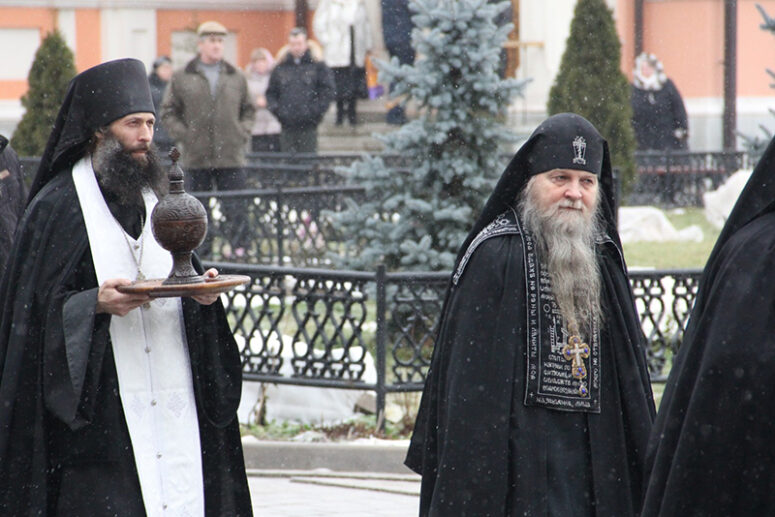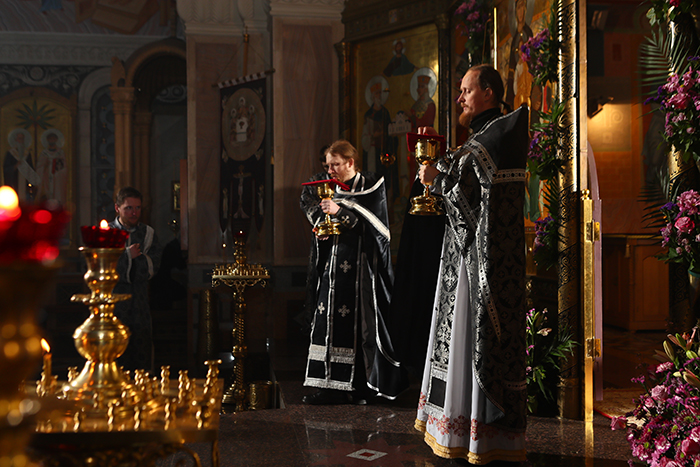
After Divine Liturgy on Sundays and holidays, the brethren will go in procession walking in pairs from the main church to the trapeza and carrying at the head of the procession the remainder of the Panagia prosphoron, from which a particle is taken out during proskomedia in honor and memory of the Mother of God. The prosphora is transferred, as a rule, by the celebrating priest (or the priest on duty), followed by the abbot of the monastery, the priestly brethren in order of their seniority, the monks and novices. In the Ecclesiastical rules this ceremony is called the Lifting of the Panagia. Since ancient times, Christians have used the word Panagia (Greek: All-Holy) for the Mother of God. In the present case it is applied to the Panagia prosphoron, symbolically representing the Queen of Heaven. The vessel containing the prosphoron is known as the panagiaron. The rite is contained in the Service Psalter (part 2, “The Lifting of the Panagia”), which also explains its origin.
According to ancient tradition, the apostles, after the descent of the Holy Spirit upon them, began leaving an unoccupied place at the table each time they gathered for a meal, placing bread there. This place was intended for the Lord Jesus Christ. At the end of the meal and after the prayer of thanks, they lifted this loaf (the corner cut) with the words: “Glory to Thee, our God, glory to Thee. Glory be to the Father and to the Son and to the Holy Spirit. Great is the Name of the Holy Trinity. Lord Jesus Christ, help us.” On Easter days,the last two exclamations were replaced with “Christ is Risen.” The apostles continued this tradition even when they went to different countries to preach. When, upon the blessed Dormition of the Mother of God, the apostles were miraculously gathered in Jerusalem and performed Her burial, on the third day they sat together at a meal. When, during the offering of the bread in memory of Christ, they said, “Great is the name …”, they saw the Most Holy Theotokos in the air, surrounded by Angels. She promised to stay with them always. The delighted disciples exclaimed in astonishment instead of “Lord Jesus Christ, help us”, “Most Holy Theotokos, help us.” After that, having gone to the tomb of the Mother of God and opening it, the apostles did not find Her most pure body there and were thus convinced that She was ascended into heaven to His Divine Son. This written version of the legend was anchored in the August book of the Great Menaion Reader (the feast of the Dormition of the Most Holy Theotokos).
The procession of the brethren to the refectory is accompanied by bell-ringing with the singing of Psalm 145, containing an adoring praise of the greatness and goodness of God. The prosphoron is then placed in the center of the table or in a designated place. At the end of the meal, Panagia is ascended before the icons with the glorification of the Holy Trinity and a prayer to the Most Holy Theotokos. Then the prosphoron is crushed into particles, and the brethren eat of it.
The fact that the Lifting of the Panagia is performed in the refectory, immediately after meal, is intended to remind us that meals in monasteries are viewed as part of the divine service, its post-Eucharistic continuation. The same is indicated by other signs: the common prayer at the beginning and at the end of the meal, the indispensable reading during meals and adherence to strict order, including the changes of courses and avoiding conversations between brethren. The outstanding professor of liturgics M.M. Skabalanovich writes, “The meaning of the ceremony is obvious – to vividly render the presence of God Himself and the Most Holy Theotokos at the meal. The same appears from the tradition of its origin […] The immediate goal of the rite is to unite the meal so closely with the just-ended Liturgy that they would both appear as one service, with the former communicating its grace to the latter. Indeed, thanks to the Lifting of the Panagia, a monastic dinner turns into a real worship service, similar to the Typical Psalms with a Compline, where a kontakion and a Hymn to the Theotokos replace the Canon (and a whole canticle from the Canon is performed on Easter)” (Explanatory Typikon, Moscow, 2003, issue II, pp. 50-51 ).
Source texts: http://dishupravoslaviem.ru/chin-o-panagii/, https://spzh.news/ru/vopros-svyashhenniku/74037-chto-takoje-chin-o-panagii.
Translated by The Catalogue of Good Deeds




